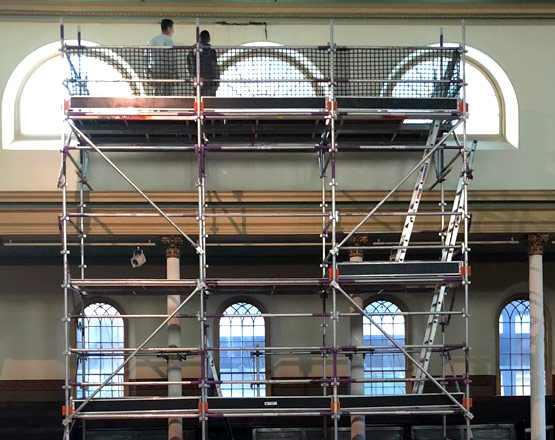In the ever-evolving environment of construction, commercial scaffolding stands as a crucial component that improves productivity and security in various projects. Ranging from towering skyscrapers to complex renovations, scaffolding offers the necessary backing and entry to work at elevated positions, guaranteeing that teams can execute their tasks effectively. But, what exactly is business scaffolding, and how come has it become essential in the modern construction industry? Grasping its significance not only helps satisfy regulatory standards but also facilitates smoother project execution, ultimately leading to successful results.
While we delve into the world of business scaffolding, we will investigate different kinds of scaffolding structures, their role in enhancing job site security, and the compliance guidelines such as OSHA regulations that govern their application. Moreover, we will underscore important considerations for choosing the right scaffolding options for your particular project needs, including tall constructions to retail and office developments. Ultimately, at the conclusion of this discussion, you will have a comprehensive grasp of how proper scaffolding strategies can revolutionize construction operations, ensuring both security and productivity at every step.
Comprehending Industrial Scaffolding
Commercial frameworks is a short-term framework used to support workers and resources during the erection or renovation of industrial structures. It provides a secure and steady platform for erection activities at various heights, allowing workforces to perform jobs effectively. Frameworks is vital in major projects where traditional ladders or framework alternatives may not suffice, enabling for greater access to various levels of a facility, improving productivity, and guaranteeing that tasks can be accomplished in a prompt manner.

There are several types of frameworks employed in industrial projects, such as frame frameworks, configurable scaffolding, and pipe frameworks. Each kind serves varied purposes and is chosen based on considerations such as the project's specific requirements, elevation, and complexity. For instance, configurable scaffolding is very versatile and can be adapted for different construction layouts, while frame frameworks is commonly used for straightforward duties that do not demand significant customization. Comprehending the distinct types helps construction managers choose the best effective method for their needs.
The role of scaffolding in contemporary building cannot be understated. It not only boosts site safety by providing secure bases for employees but also fosters to output by reducing the time laborers invest transitioning between different levels. As commercial projects often involve teams collaborating on various duties at the same time, effective framework solutions facilitate smooth operations, lessen hindrances, and promote an systematic site atmosphere. Ultimately, proper frameworks is crucial for effective project finishing, meeting timeframes, and maintaining high security criteria.
Safety and Adherence in Scaffold Systems
Ensuring safety and adherence is paramount in scaffold operations, especially in commercial projects where the risks are high. Employers must adhere to strict safety regulations set forth by agencies such as OSHA, which provide guidelines that help maintain a safe working environment for all workers involved. Adherence with these standards not only protects workers but also mitigates liability that can arise from incidents or unsafe conduct on the worksite.
Training is a vital aspect of security compliance in scaffold systems. Workers must be provided with the necessary knowledge and capabilities to recognize potential hazards and implement safety protocols effectively. This includes understanding how to conduct security assessments, proper use of equipment, and following safety guidelines. By supporting comprehensive training initiatives, companies can foster a culture of safety, ensuring that staff are vigilant and prepared to address any issues that may emerge while working at heights.
Moreover, regular maintenance and inspection of scaffold systems are essential for ongoing safety compliance. This includes checking for structural integrity, deterioration, and ensuring all parts are functioning correctly. By performing meticulous evaluations and maintaining equipment, construction companies can actively identify and address issues, thereby guaranteeing the safety of their employees and the overall effectiveness of the project. A commitment to security and adherence not only enhances worker safety but also boosts the productivity and reputation of the organization as a whole.
Scaffolding Solutions for Modern Developments
In today's fast-paced construction environment, efficient scaffolding systems are crucial for the successful completion of modern projects. With the increasing challenges and size of business builds, scaffolding methods must be flexible and responsive. Modular scaffolding has emerged as a favored choice in this landscape, offering rapid assembly and disassembly, which reduces downtime on location. This flexibility allows contractors to respond swiftly to job changes and maintain tight schedules, ultimately enhancing productivity and efficiency.
Worker safety is a top priority in any construction job, and advanced scaffolding solutions include features specifically designed to reduce risks. Current scaffolding tools often includes protective rails, non-slip surfaces, and automatic locking mechanisms to improve worker safety. Moreover, these solutions are crafted to comply with the latest OSHA regulations and industry standards, ensuring that job sites maintain a satisfactory level of safety for all workers. https://angerbeast1.werite.net/beginning-notion-until-construction-framing-your-dream tailored to educate workers with the specific scaffolding systems being used additionally bolster the commitment to a safe working environment.
The importance of scaffolding in the execution of large-scale projects, such as high-rise buildings or large commercial complexes, cannot be overstated. Effective project planning and logistics play a vital role in the scaffolding installation, including factors such as load limits and site entrance. Selecting the right type of scaffolding and recognizing the unique needs of each project ensures that construction efforts proceed smoothly. As projects continue to evolve, embracing innovative scaffolding solutions will be key to enhancing overall efficiency, maintaining safety guidelines, and achieving project success in modern construction.
